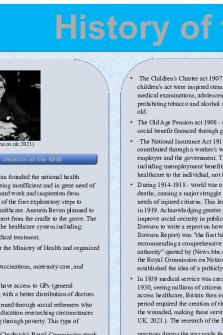The National Decision Model PDF

| Title | The National Decision Model |
|---|---|
| Course | Knowledge in Policing |
| Institution | London Metropolitan University |
| Pages | 2 |
| File Size | 56.9 KB |
| File Type | |
| Total Downloads | 83 |
| Total Views | 144 |
Summary
Bruce Harris lecture. important if you also want to go into the police service as an officer....
Description
The National Decision Model: Code of Ethics: 1) 2) 3) 4) 5)
Gather information and intelligence Assess threat and risk and develop a working strategy Consider powers and policy Identify options and contingencies Take action and review what happened
Examples for (1) include: honesty and integrity, authority, respect and courtesy, equality and diversity, use of force, orders and instructions, duties and responsibilities, confidentiality, fitness for work, conduct and lastly challenging and reporting improper behaviour What is happening? What do I know so far? What do I not know? What further information do I need at this moment? (2) Any specific threat of harm? Promote good relations/prevent discrimination? Do I need more information? Do I need to take action immediately? What could go wrong? How probable is the risk of harm? (3) This stage involves considering what powers, policies and legislation might be applicable in this particular situation. What police powers might be required? Is there any national guidance covering this type of situation? Do any local organisational policies or guidance apply? What legislation might apply? As long as there is a good rationale for doing so, it may be reasonable to act outside policy (4) This stage involves considering the different ways to make a particular decision with the least risk of harm Options to consider: The immediacy of that threat The limits of information to hand The amount of time available Available resources and support Your own knowledge, experience and skills The impact of potential actions on the situation and the public If you have to account your decision will you be able to say it was: proportionate, legitimate, necessary and ethical, reasonable in the circumstances facing you at the time? (5) This stage requires decision makers to make and implement appropriate decisions It also requires decision makers, once an incident is over, to review what happened Action: respond, implement the option you have selected, does anyone else need to know what you have decided?
Monitor: what happened as a result of your decision? Was it what to wanted or expected to happen? Review: if the incident is over, review decisions using the NDM. What lessons can you take? What might you do differently next time?...
Similar Free PDFs

The National Decision Model
- 2 Pages

The National Development Policy
- 2 Pages

The Decision Book
- 83 Pages

Advent of the National Hero
- 13 Pages

THE TRANSTHEORETICAL MODEL
- 6 Pages

The Role Model - Homework
- 5 Pages
Popular Institutions
- Tinajero National High School - Annex
- Politeknik Caltex Riau
- Yokohama City University
- SGT University
- University of Al-Qadisiyah
- Divine Word College of Vigan
- Techniek College Rotterdam
- Universidade de Santiago
- Universiti Teknologi MARA Cawangan Johor Kampus Pasir Gudang
- Poltekkes Kemenkes Yogyakarta
- Baguio City National High School
- Colegio san marcos
- preparatoria uno
- Centro de Bachillerato Tecnológico Industrial y de Servicios No. 107
- Dalian Maritime University
- Quang Trung Secondary School
- Colegio Tecnológico en Informática
- Corporación Regional de Educación Superior
- Grupo CEDVA
- Dar Al Uloom University
- Centro de Estudios Preuniversitarios de la Universidad Nacional de Ingeniería
- 上智大学
- Aakash International School, Nuna Majara
- San Felipe Neri Catholic School
- Kang Chiao International School - New Taipei City
- Misamis Occidental National High School
- Institución Educativa Escuela Normal Juan Ladrilleros
- Kolehiyo ng Pantukan
- Batanes State College
- Instituto Continental
- Sekolah Menengah Kejuruan Kesehatan Kaltara (Tarakan)
- Colegio de La Inmaculada Concepcion - Cebu









